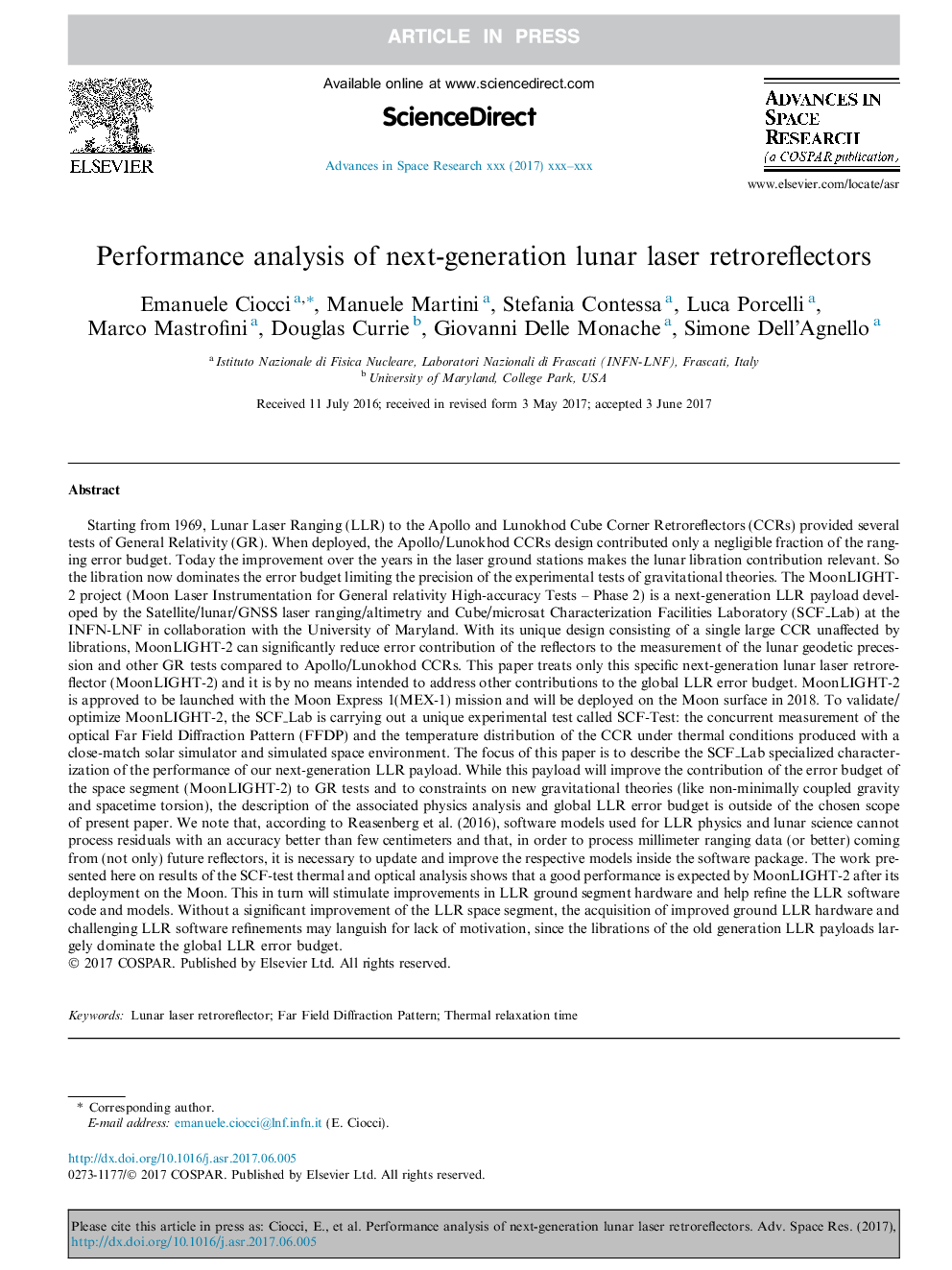| کد مقاله | کد نشریه | سال انتشار | مقاله انگلیسی | نسخه تمام متن |
|---|---|---|---|---|
| 5486568 | 1399467 | 2017 | 7 صفحه PDF | دانلود رایگان |
عنوان انگلیسی مقاله ISI
Performance analysis of next-generation lunar laser retroreflectors
ترجمه فارسی عنوان
تجزیه و تحلیل عملکرد نسل بعدی مولد لیزر ضد رفلکتور
دانلود مقاله + سفارش ترجمه
دانلود مقاله ISI انگلیسی
رایگان برای ایرانیان
کلمات کلیدی
بازتابنده لیزر قمر، الگوی دیفرانسیل دور زمان آرامش حرارتی،
موضوعات مرتبط
مهندسی و علوم پایه
علوم زمین و سیارات
علوم فضا و نجوم
چکیده انگلیسی
Starting from 1969, Lunar Laser Ranging (LLR) to the Apollo and Lunokhod Cube Corner Retroreflectors (CCRs) provided several tests of General Relativity (GR). When deployed, the Apollo/Lunokhod CCRs design contributed only a negligible fraction of the ranging error budget. Today the improvement over the years in the laser ground stations makes the lunar libration contribution relevant. So the libration now dominates the error budget limiting the precision of the experimental tests of gravitational theories. The MoonLIGHT-2 project (Moon Laser Instrumentation for General relativity High-accuracy Tests - Phase 2) is a next-generation LLR payload developed by the Satellite/lunar/GNSS laser ranging/altimetry and Cube/microsat Characterization Facilities Laboratory (SCF_Lab) at the INFN-LNF in collaboration with the University of Maryland. With its unique design consisting of a single large CCR unaffected by librations, MoonLIGHT-2 can significantly reduce error contribution of the reflectors to the measurement of the lunar geodetic precession and other GR tests compared to Apollo/Lunokhod CCRs. This paper treats only this specific next-generation lunar laser retroreflector (MoonLIGHT-2) and it is by no means intended to address other contributions to the global LLR error budget. MoonLIGHT-2 is approved to be launched with the Moon Express 1(MEX-1) mission and will be deployed on the Moon surface in 2018. To validate/optimize MoonLIGHT-2, the SCF_Lab is carrying out a unique experimental test called SCF-Test: the concurrent measurement of the optical Far Field Diffraction Pattern (FFDP) and the temperature distribution of the CCR under thermal conditions produced with a close-match solar simulator and simulated space environment. The focus of this paper is to describe the SCF_Lab specialized characterization of the performance of our next-generation LLR payload. While this payload will improve the contribution of the error budget of the space segment (MoonLIGHT-2) to GR tests and to constraints on new gravitational theories (like non-minimally coupled gravity and spacetime torsion), the description of the associated physics analysis and global LLR error budget is outside of the chosen scope of present paper. We note that, according to Reasenberg et al. (2016), software models used for LLR physics and lunar science cannot process residuals with an accuracy better than few centimeters and that, in order to process millimeter ranging data (or better) coming from (not only) future reflectors, it is necessary to update and improve the respective models inside the software package. The work presented here on results of the SCF-test thermal and optical analysis shows that a good performance is expected by MoonLIGHT-2 after its deployment on the Moon. This in turn will stimulate improvements in LLR ground segment hardware and help refine the LLR software code and models. Without a significant improvement of the LLR space segment, the acquisition of improved ground LLR hardware and challenging LLR software refinements may languish for lack of motivation, since the librations of the old generation LLR payloads largely dominate the global LLR error budget.
ناشر
Database: Elsevier - ScienceDirect (ساینس دایرکت)
Journal: Advances in Space Research - Volume 60, Issue 6, 15 September 2017, Pages 1300-1306
Journal: Advances in Space Research - Volume 60, Issue 6, 15 September 2017, Pages 1300-1306
نویسندگان
Emanuele Ciocci, Manuele Martini, Stefania Contessa, Luca Porcelli, Marco Mastrofini, Douglas Currie, Giovanni Delle Monache, Simone Dell'Agnello,
